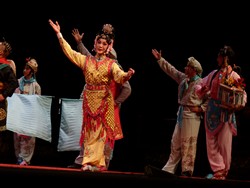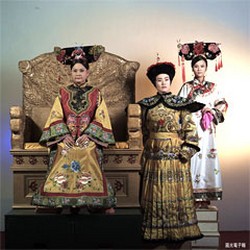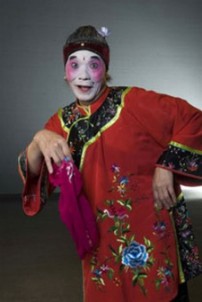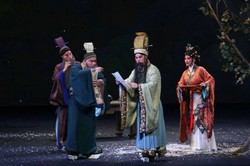
The excellent performance of the actors come from applauds of the audience.
It is different from appreciating Chinese opera than that of western opera that the former audience can directly interact with the actors.For instance, an actress moving up her arm by using long sleeve to cover the sight of another actor and faced to the audience to tell her inner words, and pretended the other actor could not hear what she said.It is called “da bei gong”.Watching Chinese opera is not that limited as Western opera.Audience may react and evaluate the actor any time during the performance.Affected by the encouragement of the audience, actor would perform harder.In this way, the warm and enthusiastic atmosphere were full of the theater, on and off stage coherent.
A. Chinese opera is a composite art
The characteristics of Chinese opera are, first of all, its performance per se is a very complicated composite art.As we knew, all the drama is composite art.That means: drama includes literature, performance, art production, lighting and so on.In Chinese opera, just take performance, it is in itself a composite art that includes four categories: reading, singing, performing, and fighting.If included music, art (i.e., make-up, facial, staging design, and setting drawing and so on), lighting, costume (embordierment), properties (hand-made products), then Chinese opera is really a very complicated composite art.

Chinese opera contains high performance form and artistic content.
B. Stage of Chinese opera is beyond the limit of time and space

The stage and property of Chinese opera are not limited by time and space.
Another feature of Chinese opera art is it can not treat the natural form of life move to the stage realistically.The stage of Chinese opera is not big enough, and there has no setting, just some simple properties (Qie mo).Due to not limited to time and space, it is on the contrary flexible.No matter on the sky or into the sea, on the mountain or on the ground, the stage is not only very convenient, but save lots of unnecessary words.And it can be more concentrated and concise to represent special dramatic effect.Audience can understand fully.For film or stage drama, audience see the picture or setting then realized the time and space.However, for Chinese opera, without the actor on the stage, audience will not tell the time and place.It has to be by the reading and singing of the actors with their movements to drag the audience into the opera.This is the fantasy of Chinese opera.
C. Role type of Chinese opera has its own style and characteristics

In the Chinese opera, there are various role performed.
The role type of Chinese opera is called “hang-dang” (profession), primarily divided according to gender, age, status, identity, character, and temperament of the role in the opera .The division of “hang-dang”was derived from old opera kinds such as kun chu and hui han.In the early stage, it is divided as ten roles: sheng, tan, mo, uai, chin, chou, za, shan sho, xia sho, and liu xing.Later, due to the development of performing art and the abundance of script, the strict “hang-dang”division was broken through, and combined as the four major “hang-dang”—sheng, tan, jing, chou.Each “hang-dang”includes several various role types.
D. Vocals of Chinese opera and Instrumental Music contains rich musical stage language
The major vocals are “Xi Pi” and “Er Huang;” in short, it is called “Pi Huang”.They are divided into certain “patterns and styles”.These “ban shih’s” are developed and evolved by one kind of music tone.The difference is on its strong and weakness, wholeness and scatter of tempo, tightness and looseness of temper, and fast and slow of speed as well, and so on.These “ban shih’s” can be singly as section, or connected as a set.Different “ban shih’s” expresses different emotion.In order to cope with performance, describe surrounding, and enhance atmosphere, normally certain instruments were played.This is called “song title”.These song titles can be long or short.Some used so-na and flute, other used hu chin; each has its various usages.Bongo and gong have important position in Chinese opera; reading, singing, performing, and fighting all need them.The feature of bongo and gong is strong sounding, clear tempo.It is used to emphasize temper and create atmosphere.Such as battle setting, should there be no bongo and gong, it would be hard to imagine.
Reading lines (talking and speaking) in Chinese opera has its own feature.It is primarily divided into “jing pei” and “un pei”.Jing pei is the Beijing mandarin after initial fix-up, with more exaggerated tone and intonation and fast or slow tempo.Hua tan and chou role are both reading “jing pei”.“Un pei” does not use Beijing mandarin, but “zhong zhou tone,” which sounds very different from Beijing mandarin.It is the stage language been further fixed up with even more exaggerated temper and tone, more rhythmic and beauty in its tempo.Lao sheng, qing I, hua lian, xiao sheng, and lao tan are all reading “Un pei.”Reading words may concisely and clearly express thoughts; it has the unique expression power.
| Besides singing well, actor has to read with intonation. | Music by the orchestra in Chinese opera performance plays a key role to let the opera shine. |
E. Different Role playing would have different corresponding costume and facial make-up

In Chinese opera, each role has different costume and make-up.
Traditional opera titles were mostly adopted historical stories to reflect life of each dynasty, representing characters of empires, kings, royal families, talent men and beautiful ladies, and people of all levels.Each dynasty and men of different status had different costumes.Playing of various roles forced opera artists to wear costumes in a set of rules.The style of costume is the important mark representing social status of the role.Different wearing opf costume also embodied different setting.A waist skirt outside the clothes, walking with two hands touching corner of the skirt, that represents sadly hurry here and there for living.The two winding belts on the back of head for wen sheng, put on the side of the towel and had a knot on the left side also could meant hurry on the way.Prior to the General going for a war, with tight kao and wearing mang that would let audience feel hurry and heavily for the battle.
Reference:
Hua Xia Jing Wei http://big5.huaxia.com/wh/ /sorted by the research team
Source of photos: authorized and provided by Guoguang Opera Company
Source of film: authorized and provided by Guoguang Opera Company
